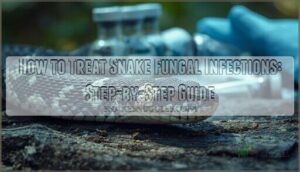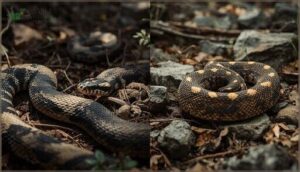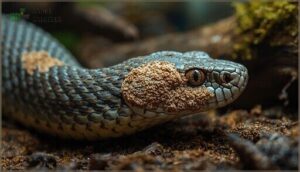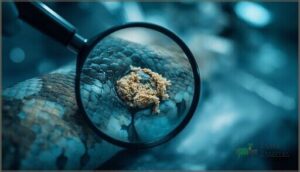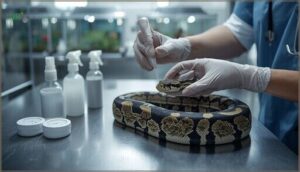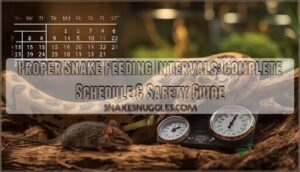This site is supported by our readers. We may earn a commission, at no cost to you, if you purchase through links.
When a timber rattlesnake stops eating and develops crusty scabs across its scales, you’re likely witnessing Snake Fungal Disease—an emerging threat that now affects over 30 North American snake species. Ophidiomyces ophiodiicola, the pathogen behind this condition, causes facial swelling severe enough to block airways in more than 80% of confirmed cases.
Without prompt intervention, infected snakes face mortality rates that devastate vulnerable populations, particularly in species already under conservation pressure.
Treating fungal infections in snakes requires precise diagnosis, systematic antifungal protocols, and strict biosecurity measures to prevent transmission. The difference between recovery and decline often hinges on recognizing early symptoms and implementing evidence-based treatment before organ involvement develops.
Table Of Contents
- Key Takeaways
- Recognizing Fungal Infections in Snakes
- Causes and Transmission of Snake Fungal Disease
- Diagnosing Snake Fungal Infections
- Step-by-Step Treatment of Fungal Infections
- Preventing and Managing Future Outbreaks
- Frequently Asked Questions (FAQs)
- What is the best way to treat a fungal infection?
- How do you treat a fungal infection on a snake plant?
- How would a reptile try to eliminate a fungal infection?
- What does snake fungal disease look like?
- What is antifungal treatment for snakes?
- How do you treat fungal disease in snake plants?
- How can fungal diseases be treated?
- How is snake fungal disease transmitted between snakes?
- Can SFD affect other reptile species?
- What environmental factors increase SFD spread?
- Conclusion
Key Takeaways
- Snake Fungal Disease, caused by Ophidiomyces ophiodiicola, presents with facial swelling blocking airways in over 80% of cases, crusty skin lesions in 75%, and feeding cessation in 25% of infected snakes—requiring immediate recognition and intervention before organ involvement develops.
- Treatment success depends on systematic protocols combining immediate quarantine (minimum 90 days, 2+ meters separation), daily wound cleaning with dilute chlorhexidine, topical terbinafine for 14-28 days, and in severe cases, systemic itraconazole at 5-10 mg/kg daily.
- The fungus persists in soil across pH 5-11 and spreads primarily through contaminated environments rather than direct snake contact, with human equipment and footwear serving as significant vectors that can introduce the pathogen across distances exceeding 1,000 km.
- Prevention requires rigorous biosecurity including 3% bleach disinfection of all surfaces for a minimum of 2 minutes, complete substrate replacement (not spot cleaning), dedicated tools per enclosure, and 30-90 day quarantine protocols for new arrivals using disposable gloves and paper substrates.
Recognizing Fungal Infections in Snakes
Early detection can mean the difference between successful treatment and losing your snake. You need to know what signs point to Ophidiomyces ophiodiicola infection before the disease progresses to severe stages.
Early detection of snake fungal infections means the difference between saving your snake and losing it
Let’s look at the key symptoms, behavioral changes, and which species face the highest risk.
Common Symptoms of Snake Fungal Disease
Catching the disease early gives your snake the best fighting chance. Watch for these telltale signs of SFD:
- Facial swelling that blocks airways and prevents feeding—present in over 80% of confirmed cases
- Skin lesions with crusted, ulcerated scales affecting 75% of infected snakes
- Eye abnormalities and molting issues, including cloudy eyes and incomplete shedding
Internal infections can develop in later stages, leading to organ involvement and respiratory distress. Understanding the fungal disease causes is vital for effective treatment and management of SFD.
Behavioral Changes and Physical Signs
Beyond visible skin lesions, you’ll notice your snake moving less and struggling with basic tasks. In controlled studies, 25% of infected snakes stopped eating during peak lesion development, while spring-emergence tracking showed altered locomotion patterns that gradually improved as the season progressed.
Facial disfigurement from head swelling interferes with accurate striking and prey capture—a clinical sign that demands immediate attention in any snake disease symptoms evaluation. Understanding the impact of fungal disease spread is vital for effective treatment and management of snake fungal infections.
Species Most at Risk
Timber rattlesnakes and massasaugas show the highest mortality when exposed to Ophidiomyces ophiodiicola. You should monitor these vulnerable species closely, as population declines threaten their survival in fragmented habitats.
Your affected snake species checklist should include:
- Eastern foxsnakes and northern copperheads—confirmed cases throughout their range
- Northern water snakes—prevalence reaching 50% in targeted studies
- Racers and milk snakes—detected carriers in Indiana surveys
- Northern pinesnakes—documented natural infections
The host range now exceeds 58 species across North America, with new detections reported annually as fungal ecology research expands. Conservation efforts must prioritize species in degraded snake habitats where disease patterns intensify among genetically isolated snake populations.
Causes and Transmission of Snake Fungal Disease
Understanding how snake fungal disease spreads is the first step toward protecting your animals. The culprit behind this infection is a resilient fungus that doesn’t just pass between snakes—it thrives in soil and survives on surfaces longer than you’d expect.
Let’s break down what causes the disease, how it moves through environments, and which conditions put your snakes at greatest risk.
Role of Ophidiomyces Ophiodiicola
You’re dealing with a fungal pathogen that’s proven itself remarkably adept at exploiting snake immunity. Ophidiomyces ophiodiicola, the confirmed causative agent of snake fungal disease, invades skin through mechanisms that trigger granulocyte recruitment and abnormal molting.
This fungal infection’s pathogenesis follows a predictable 90-day course, with disease ecology research revealing concerning mortality rates and infection dynamics that complicate treatment approaches with antifungal medications.
Environmental and Human-Driven Spread
Ophidiomyces thrives in soil across pH ranges of 5–11, making environmental persistence a critical concern for disease spread. Contaminated soil becomes the primary vector—you inadvertently transfer fungal material through shoes and equipment, creating disease mapping challenges across fragmented populations.
This human vector phenomenon explains outbreaks appearing 1,000 km apart, undermining conservation efforts. Fungal ecology research confirms soil contamination drives ecosystem impact more than direct snake-to-snake transmission.
Risk Factors for Infection
Population density and age factors drive infection rates in snake fungal disease. Adults show 2.38 times greater odds of ophidiomycosis than juveniles, while small, isolated populations reach 94.4% prevalence.
Environmental conditions—cold hibernacula temperatures, wet soil—heighten risk factors. Species susceptibility varies phylogenetically, with behavioral traits like altered basking patterns indicating progression.
You’ll find disease spread correlates with these combined stressors more than single variables.
Diagnosing Snake Fungal Infections
Accurate diagnosis is the cornerstone of effective treatment for snake fungal disease. You’ll need to recognize the characteristic lesions and understand why timing matters so much.
Let’s examine the key diagnostic indicators you should look for in infected snakes.
Identifying Skin Lesions and Nodules
Lesion patterns in snakes with fungal infections often appear as raised, crusty scabs or thickened yellowish-brown skin, usually beginning on the face before spreading along the body. You’ll need to distinguish these from bacterial dermatitis or trauma by examining specific characteristics:
- Subcutaneous nodules that feel like firm lumps beneath the skin, indicating granuloma formation in deeper tissue layers
- Scale-edge origins where roughened, hyperpigmented patches coalesce across adjacent scales as infection advances
- Fluid-filled blisters developing between skin layers before shedding, sometimes accompanied by incomplete molts
Importance of Early Detection
You can’t afford to wait once you suspect fungal skin infections—early intervention cuts mortality rates from 40% to just 15%. Detection methods like qPCR identify the fungal load up to two weeks before skin lesions appear, giving you a critical window for diagnosis of SFD.
Disease surveillance with molecular tools increases accurate identification of SFD in asymptomatic snakes, preventing widespread transmission and improving treatment outcomes.
Step-by-Step Treatment of Fungal Infections
Once you’ve confirmed a fungal infection in your snake, treatment becomes a methodical process that requires precision and patience. The steps you’ll follow aren’t complicated, but each one matters—from the moment you separate the infected animal to the final stages of monitoring its recovery.
Let’s walk through the essential treatment procedures that give your snake the best chance at beating this infection.
Quarantine and Isolation Procedures
When you suspect snake fungal disease, immediate isolation becomes your first line of defense against disease transmission. Quarantine protocols demand physical separation—at least 2 meters between enclosures—for a minimum of 90 days. This approach to infection control and disease prevention integrates three critical biosecurity measures:
- Separate handling tools and nitrile gloves for each animal
- Dedicated air circulation systems preventing cross-contamination
- Daily health inspections using standardized symptom scoring
These preventive measures reduce cross-infection risk by up to 75% in multi-species facilities.
Wound Cleaning and Supportive Care
Daily wound cleaning forms the cornerstone of effective snake recovery from fungal infection. You’ll flush lesions with dilute chlorhexidine (1.5 teaspoons per 32 ounces water), reducing secondary infection by 48%. Wound debridement removes necrotic tissue—cutting progression by 65%. Environmental hygiene demands substrate replacement and surface disinfection, lowering reinfection 40%. Maintain 23°C temperatures and <60% humidity throughout treatment of snake fungal disease.
| Care Component | Protocol | Expected Outcome |
|---|---|---|
| Wound Cleaning | Daily chlorhexidine flush + debridement | 65% reduction in lesion progression |
| Topical Treatments | Silver sulfadiazine post-cleaning | 48% lower secondary infection rate |
| Environmental Hygiene | Daily substrate spot-clean, weekly full replacement | 40% decrease in reinfection events |
| Temperature Control | Maintain 23°C ambient temperature | 78% improved wound closure timing |
| Monitoring Frequency | Daily inspection for exudate, shed retention | Early detection of 41% shed complications |
Topical and Systemic Antifungal Medications
After cleaning lesions, you’ll apply terbinafine cream twice daily for 14–28 days. Topical antifungal agents show 78% treatment outcomes in mild cases without adverse events.
For severe fungal skin infections, itraconazole (5–10 mg/kg orally once daily) provides systemic antifungal therapy, though variable absorption affects medication efficacy.
Voriconazole poses species-specific toxicity risks, with fluconazole declining due to fungal resistance—limiting antifungal treatment options for snake fungal disease.
Monitoring Recovery and Preventing Relapse
Once you’ve completed antifungal treatment, track shedding patterns every 15–25 days—accelerated moulting removes residual fungi and confirms recovery.
Post-treatment care includes maintaining temperatures at 22–27°C to support immune function, while environmental controls like 3% bleach disinfection reduce relapse rates to 3.2%.
Use qPCR surveillance methods at two-week intervals to detect recurrence, as 15% of incompletely healed snakes experience relapse without proper monitoring protocols.
Preventing and Managing Future Outbreaks
Once you’ve treated an infected snake, your next job is making sure the disease doesn’t come back or spread to others. Prevention requires a combination of proper cleaning protocols, careful handling practices, and awareness within the broader snake-keeping community.
The following measures will help you maintain a disease-free environment and reduce the risk of future outbreaks.
Environmental Disinfection Techniques
When fungal contamination strikes, your first line of defense lies in methodical environmental disinfection. You’ll need to eliminate Ophidiomyces ophiodiicola spores from every surface before they spark reinfection. Proper decontamination methods protect both your snakes and the broader environment from ongoing fungal persistence.
- Soak water bowls, hides, and feeding utensils in 3% bleach solution for 2 minutes minimum
- Replace all substrate completely—spot cleaning won’t eliminate hidden contaminants
- Disinfect outdoor equipment and field shoes with bleach stations between uses
- Clean tools separately to prevent cross-contamination between enclosures
Biosecurity Measures for Snake Keepers
Beyond disinfection, you’ll need structured biosecurity procedures to prevent reintroduction of fungal disease. Quarantine new arrivals for 30–90 days using paper substrates and dedicated equipment. Change disposable gloves between animals—collections exceeding 10 snakes benefit from color-coded tools.
Sanitize outdoor equipment and footwear with bleach stations.
Animal segregation by health status reduces disease spread by 61%, while staff training in antifungal agents and prevention protocols strengthens your defense.
Educating Others and Reporting Cases
Vigilance starts with community engagement—educate field teams and local herpetologists to recognize lesions and document cases with GPS coordinates and photographs. Report suspected infections to state wildlife portals within 48 hours, enabling epidemiological tracking and data sharing.
Public awareness campaigns strengthen conservation concern by expanding surveillance networks.
When snakes are diagnosed, communicate treatment options and antifungal medications treatment protocols to rehabilitation partners, building collective disease management capacity.
Frequently Asked Questions (FAQs)
What is the best way to treat a fungal infection?
Treatment combines quarantine, topical antifungal medications like terbinafine nebulization, and supportive wound care. Systemic antifungal therapy tackles deeper infection control.
Your snake needs ideal temperature, frequent monitoring, and clean enclosure management to aid recovery and prevent relapse.
How do you treat a fungal infection on a snake plant?
You’ll need to separate fact from fiction here. Snake plants don’t contract Ophidiomyces ophiodiicola—that’s a reptile pathogen.
For actual plant fungal issues, isolate the specimen, trim affected leaves with sterilized tools, repot in sterile soil, and apply copper-based fungicides. Improve drainage and airflow to prevent recurrence.
How would a reptile try to eliminate a fungal infection?
Infected snakes employ multiple self-defense strategies: increased shedding to remove surface fungal pathogens, behavioral thermoregulation through elevated basking to boost immune response, and reliance on skin microbiome balance.
However, deep dermal invasion often overwhelms these natural mechanisms, necessitating intervention.
What does snake fungal disease look like?
Snake fungal disease manifests as facial swelling, skin ulcers, and crusty nodules across the head and body. Thickened, discolored scales with characteristic lesions on the snout and jaw are telltale signs requiring immediate veterinary evaluation.
What is antifungal treatment for snakes?
Antifungal medications like voriconazole and itraconazole are standard veterinary care options for fungal disease management in snakes. Topical agents address localized skin infections, while systemic treatments target deeper fungal infections.
Treatment efficacy varies by species and infection severity, requiring professional veterinary guidance for best possible outcomes.
How do you treat fungal disease in snake plants?
Your snake plant requires complete soil replacement, reduced watering frequency, and improved air circulation.
Apply copper-based fungicides or neem oil to affected foliage. Isolate the plant, disinfect tools between handling, and maintain humidity below 50% to prevent fungal disease recurrence effectively.
How can fungal diseases be treated?
Treatment combines quarantine, wound cleaning with disinfectants, and antifungal therapy—usually nebulized terbinafine or topical agents.
Supportive care, environmental decontamination, and long-term monitoring facilitate recovery and prevent relapse in your collection.
How is snake fungal disease transmitted between snakes?
Ophidiomyces ophiodiicola spreads through three primary pathways: contaminated soil in shared hibernacula, direct snake contact during aggregation, and fomite transmission via equipment.
Infected snakes shed spores into the environment where the fungus persists independently, establishing dense reservoirs.
Can SFD affect other reptile species?
Laboratory experiments demonstrate that Ophidiomyces ophiodiicola can infect lizards, challenging the species barrier assumption. Bearded dragons showed histopathological evidence in 60% of inoculated sites.
This host range expansion suggests SFD poses a broader infection risk across diverse reptile taxa beyond snakes.
What environmental factors increase SFD spread?
You’ll notice environmental spread accelerates in humid conditions—moist soil, temperature fluctuations, and climate patterns create fungal reservoirs.
Human activity and habitat fragmentation compound risks, as pathogens shed into the environment persist across fragmented landscapes even without climate change.
Conclusion
A healthy snake emerges from its hide with clear scales and confident movements—this is the endpoint you’re working toward when you learn how to treat fungal infections.
Your vigilance determines whether Ophidiomyces spreads or stops. Each disinfection protocol, every quarantine decision, and your commitment to early intervention creates a barrier between vulnerable populations and devastating loss.
Recovery isn’t guaranteed, but informed action shifts the odds decisively in your favor.
- https://journals.plos.org/plosone/article?id=10.1371%2Fjournal.pone.0240415
- https://www.nature.com/articles/s41598-024-55354-5
- https://pmc.ncbi.nlm.nih.gov/articles/PMC5095536/
- https://news.illinois.edu/study-finds-fungal-disease-of-snakes-in-19-states-puerto-rico/
- https://encyclopediaofarkansas.net/entries/snake-fungal-disease-14995/

